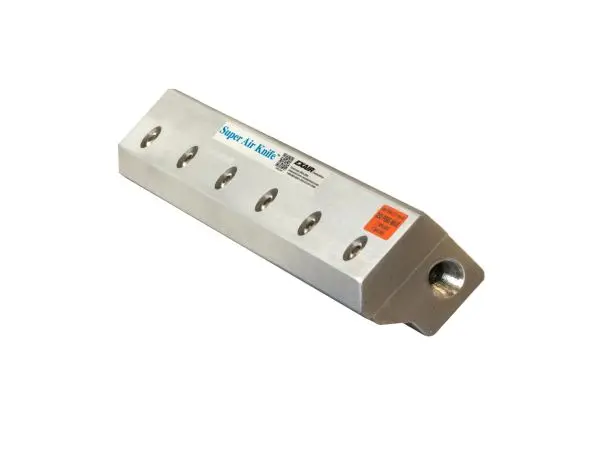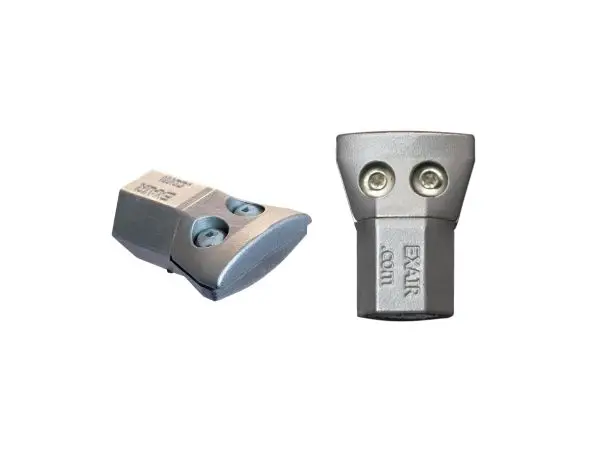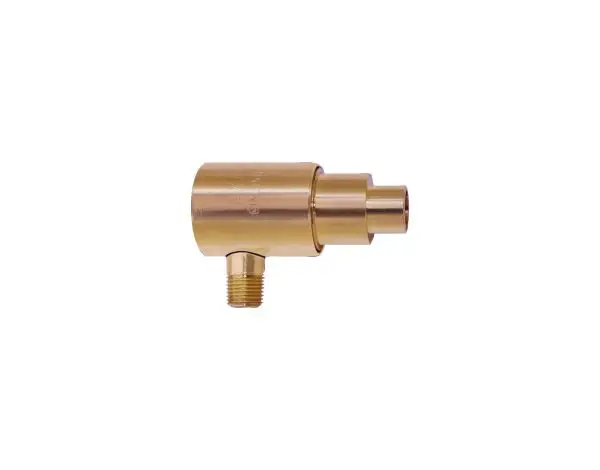The drying of products by using compressed air enhancement devices is achieved in two main ways. Firstly, the increased air flow will aid the natural evaporation of the fluid from the target. The rate of evaporation depends on the relative humidity of the air in contact with the surface being dried. If the contact air is very dry then it will more rapidly absorb water. As water evaporates the localised air around the product become saturated with water and so the evaporation process slows. If the air is replaced with new dry air continually then a constant high evaporation rate can be maintained. A further advantage of using compressed air is that it is often much drier than the ambient air in the factory so, unlike blowers, this generates a less humid air flow in many cases.
The second important mechanism of drying is direct water blow off. The impact of their current literally blows water droplets from the surface being dried rather than evaporating it. Of course, the evaporative drying effect is still amplified by these systems as well.
Engineering Consideratons
Evaporative Drying
The basic physics of every evaporative drying process is to help maintain a low level of humidity in the air immediately surrounding the object being dried. Air with less water vapour in it will absorb water faster than humid air. If the air is completely saturated (100% humidity) then no further water evaporation and drying can occur. If, on the other hand, air is completely dry with no water vapour in it then its ability absorb water, and hence dry objects, is at a maximum.
So, it follows, that if the drying object is in still air then its will quickly raise the humidity of the air in the local vicinity. In time this water vapour will in turn be absorbed by drier air further out from the object but this movement of water along a humidity gradient will take some time this is particularly true if the ambient air is also humid. So, if we can rapidly replace the localised air with fresh dry air then the process of evaporation can be maintained at its initial maximum level. This is, basically, how all blowers aid drying.
Compressed air enhancement systems have and added advantage over fan or other types of blower. The compressed air used is typically much dryer than the ambient air. This being the case the localised air around the product being dried will be maintained at a lower humidity and hence have a higher moisture absorption rate. In humid ambient environments, as found in many production environments, this means that compressed air-drying systems can offer increased drying.
When selecting compressed air enhancement products for drying applications it is, generally, the volume of air moved over the target that is of primary concern. With large volumes of air being moved continually over the drying target we help maintain the necessary low humidity of the localised air and, hence, improve the rate of drying. As such air amplifier are often a very good choice of product for drying processes that rely entirely on evaporative drying. Air amplifiers can entrain surrounding air by up to a factor of 17:1 meaning that for every m3 of compressed air put through the amplifier 17m3 of ambient air will be entrained and moved. These large air volumes tend to move fairly gently when compared to the air streams produced by other compressed air enhancement devices like air knives. Again, this might be an advantage in many drying applications where powerful, high force, air currents might damage the product being dried.
Air Blow-off Drying
The process of blasting water from a target that needs to be dried is distinct from the process of evaporative drying. With a blow off drying action the force of the air, rather than its water absorption properties, are used to drive the water from the target. Of course, evaporation also takes place as a secondary drying process as well.
As the objective of the exercise is to drive water from the target success depends on the air force being applied. Rapidly moving, focused air currents will help blast water from the surface being targeted. In general, the higher the impact (velocity) of the air the more rapidly the object will be dried. This is particularly true if the target is odd shaped like a bottle. Due to the shape of the bottle, regardless of which side the drying air blast is coming from some of the surface will be shielded from the initial blast. Air will tend to move around the entire object but this will be at a greatly diminished velocity when compared to its initial contact point. So, if we can maximise the initial contact velocity we can preserve enough air impact to deliver effective water blow off to the shielded parts of the target surface.
The need for high impact air force means that air-edgers, air knives and air jets are the most commonly used products.
Air edgers are a good choice when maximum impact is required. For example, the product is very wet or moving rapidly on a conveyor OR when the object has a complex surface and so parts are shielded from the initial air contact.
Air blades are and excellent choice for any object that can travel through the internal diameter. They deliver 360 degree high impact air flows and so will target the object being dried from all angles. The obvious limitation of the air blades is that they have a maximum size of about 11” diameter and so are not suitable for large objects.
Air knives deliver high impact and very focused linear streams of air. Air knives can be made in lengths up to 54” (1371mm) and can also be daisy chained together to form even longer lengths. Air knives are a perfect water blow off solution for conveyor systems.
Air jets produce high impact and fairly narrowly focused streams of air. This makes these products suitable for many water blow-off drying systems. Typically, they would be used on parts drying systems as a dual action systems where they help enhance evaporative drying as well as delivering some initial air blow off drying.
Maintenance and Reliability
When compared to blower systems enhanced compressed are blow off systems are very easy to maintain. Whether the system is comprised of air nozzles, air amplifiers, air jets or air knives there are no moving parts involved and no external power is required. This means that there is virtually nothing to go wrong with the blow off system. Similarly vortex tube powered coolers have no external power source or moving parts are so are equally reliable and maintenance free.
The simplicity of these systems means they can be deployed in areas that would preclude the deployment of powered blowers. In dirty, wet or humid areas of the production facility any powered equipment requires often costly protection to prevent it breaking down. This may involve water proofing or additional filtration / dust protection. Compressed air systems require none of this and so, in such environments, they are intrinsically more reliable.
Noise Levels
Noise is a constant hazard when using air systems. Both blowers and compressed air blow off systems can be very noisy and constant exposure to high noise levels is a big health and safety concern. Indeed, there is stringent legislation in many countries that limit workers exposure to certain noise levels in the work place. As such noise reduction is often a critical design factor in air blow off applications.





